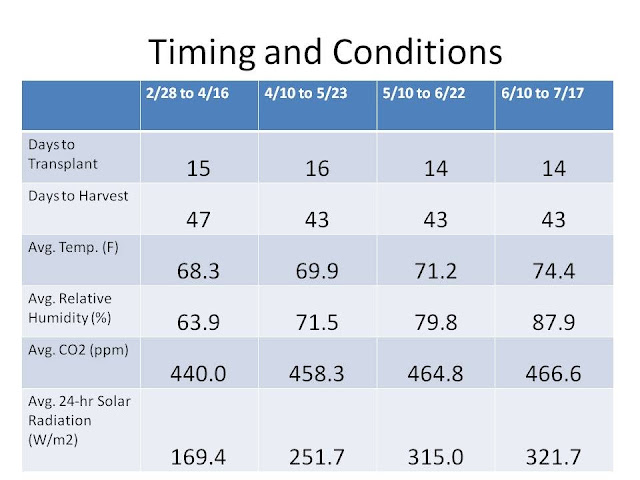Spring
to Summer Romaine Lettuce Trial
Romaine in NFT production in Ohio
By: Dr. Natalie Bumgarner
Introduction
Romaine lettuce can sometimes be a challenging lettuce
crop to produce in the greenhouse due to its susceptibility to tipburn and related quality
deterioration. However, there often appears to be a solid market for high
quality, locally produced, romaine. In addition to environmental challenges,
romaine cultivars specifically bred and developed for controlled environment
production are less common than bibb cultivars. This trial was designed to evaluate a selection of romaine lettuce cultivars
through a range of spring
and summer conditions to
evaluate their potential for greenhouse growers in the Midwest and northeast.
Methods
and Management
Primed and pelleted seeds were seeded by hand in pre-moistened 1” x 1” x 1
½” rockwool cubes. Seeds were
germinated in clear water in seeding trays, and were transferred to the nursery
and nutrient solution 4 to 7 days after seeding. Seedlings were produced in
flowing nutrient solution in the nursery for
approximately an additional week before transplanting (Run 1 and 2 were
provided supplemental lighting during the seedling phase). After transplanting,
lettuce plants were grown out in the channel for approximately four weeks prior
to harvest. The nutrient solution was continually cycled through the Fertroller where automatic pH
and EC adjustments met programmed solution set points. The pH was maintained at
5.8 by the addition of dilute sulfuric acid. EC was maintained at 1.6 to 1.8
(lower light levels = higher EC) by the addition of concentrated fertilizer solution
and source water.
* It is important to note that these trials were carried
out over set periods of time and harvests were made regardless of plant
readiness for sale because clear comparisons were the main goal. In a
commercial operation, more (or less) time may have been give these heads to
reach a consistent saleable size and crop quality.
Transplants
2 weeks after seeding
Some
thoughts on the trial
In these data, there are a few items that are important
to consider and understand about this trial.
1) The first
important fact to glean from these numbers is that the performance of the
cultivars was fairly consistent, even though there were large variations across
runs. Green Forest and Salvius tended to be the higher yielding cultivars (in all runs
except #2, discussed below) while Helvius was intermediate and Maximus and Counter were the two lower yielding cultivars in
most trials. It is useful for growers to see that across both spring and summer
conditions, these trends were fairly consistent. The yield trends could be
influenced by the growth habits of these plants. Green Forest and Salvius were usually taller
plants that were open longer while Helvius tended to form a head a little earlier. Maximus was a very open
cultivar in most of our trials while Counter formed a smaller head. Cultivar
choices should be made both on yield potential but also the plant form suitable
for markets.
2) Nutrient solution conditions may have been a key factor.
In viewing these
numbers, there are a couple of key items to keep in mind. During the middle of
May, we had an issue with our source water here at CropKing. The softener that
we were relying upon was not functioning properly and the plants were receiving
higher than optimum levels of sodium. This solution issue likely led to reduced
growth and increased tipburn in run 2. Our new
reverse osmosis system was installed on May 21st to correct these
issues. However, we then had a chlorine
spike in our municipal water source that created some root damage and plant
stress on June 13th.
(Source water may need to be the topic of
a blog post in the near future!)
So, it was likely not until the 4th run that impacts of
the improved source water quality can be observed. Keep in mind, though, that
higher summer light and temperature were likely also a source of the higher
yields in run 4. Temperature in Ohio was quite moderate for most of June and July
and these crops were grown without a shade cloth on the greenhouse to take full
advantage of available light. As with most contributors to plant growth, light,
temperature and the impact of other stresses often cannot be completely
separated in greenhouse work.
3) There were some differences in quality across the
runs and the cultivars. Specific data on
plant quality was not collected in this study in a way that allows statistical
comparisons. However, it should be noted that Counter had some heads with tipburn in all 4 runs (see
below). Tipburn was observed mainly
in Counter in Run 1 and in all cultivars in Run 2, while tipburn levels in all
cultivars were reduced in runs 3 and 4.
A
picture is worth a thousand words..
 |
Counter Run 1
|
 |
Counter Run 4
|
 |
Green Forest Run 1
|
 |
| Green Forest Run 4 |
 |
Salvius Run 4
|
 |
Helvius Run 4
|
 |
Helvius Run 1
|
 |
Salvius Run 1
|






